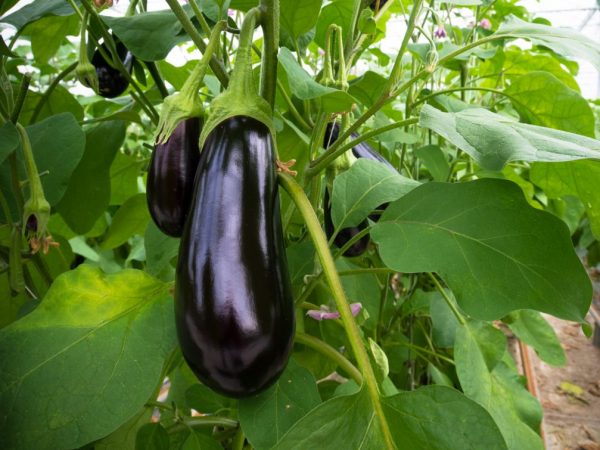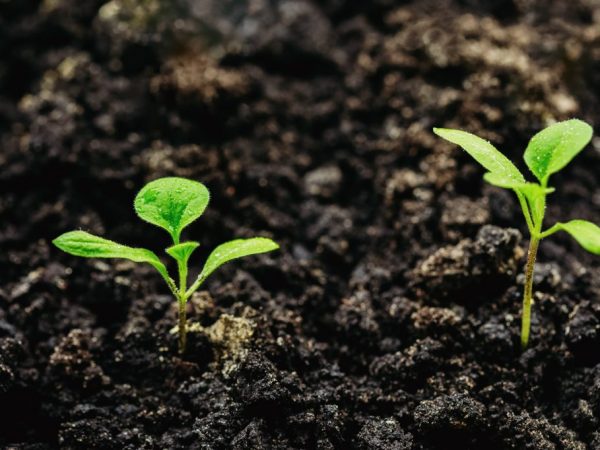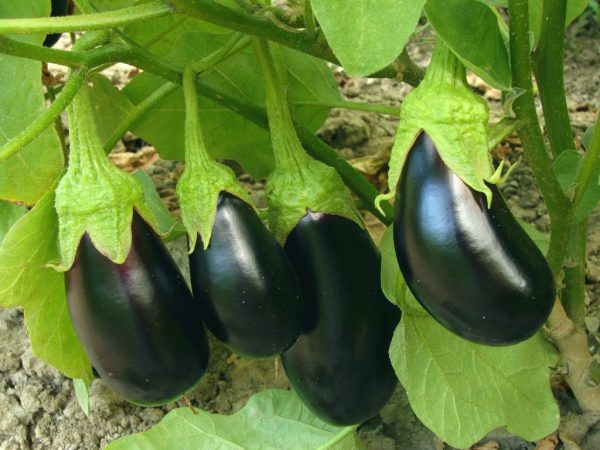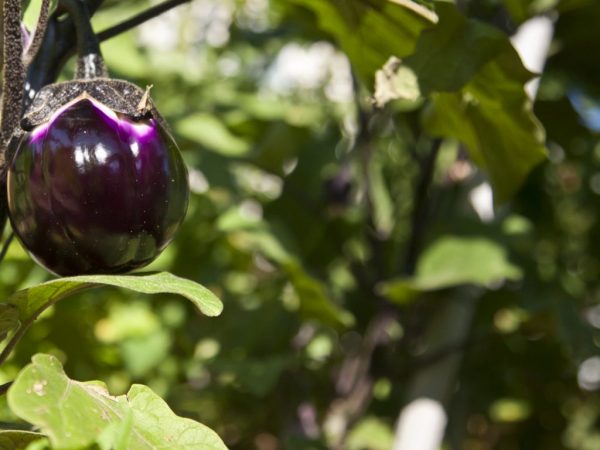Varieties and features of growing eggplant
Many gardeners are engaged in the cultivation of Eggplant. This spicy vegetable is suitable for planting in the southern regions of our country. There are many types of this vegetable, on which the cultivation characteristics depend.
- Features of the vegetable
- Interesting Facts
- Chemical composition of fruits
- Calorie content and application
- Growing
- Seed selection
- Pre-sowing treatment
- Planting dates
- Substrate preparation
- The choice of planting capacity
- Planting seeds
- Seedling care
- Temperature
- Lighting
- Watering
- Fertilizer
- Topping
- Seedling hardening
- Transfer to the garden
- Growing problems
- Yellowing of seedlings
- Rotting plantings
- Ovaries are not formed
- Diseases and pests
- Popular varieties

Varieties and features of growing eggplant
Features of the vegetable
Interesting Facts
Eggplant is an annual herb of the Solanaceae family. Blue native to the Middle East and South Asia. The distant ancestor of Eggplant grows on the Indian Peninsula.
In Turkey, this vegetable is called the Armenian cucumber or bilingjan. In our country, purple vegetables are called blue. In the Middle Ages, the fruits of this culture were called crazy apples. This is because the population of Europe did not know how to properly store and prepare eggplants. After eating them, people have many side effects - gas formation, insanity and hallucinations.
Eggplant is grown as a cultivated plant, as well as a vegetable for preparing various dishes and snacks.
Chemical composition of fruits
Almost every type of eggplant contains natural sugars, pectins, tannins, dietary fiber, organic acids and a lot of fiber. Also, a mature vegetable contains a whole complex of B vitamins, ascorbic and niacin acid, trace elements (potassium, calcium, iron, aluminum, zinc, cobalt, manganese).
Calorie content and application
This vegetable is ideally suited for dietetic food. 100 g of pulp contains 26 calories. A wide variety of dishes are made from eggplants. They are stewed, fried, boiled. The purple vegetable is an essential part of Caucasian cuisine. It is readily used in the preparation of Russian cuisine.
Growing
Seed selection

We plant only proven varieties
You can get a rich and high-quality harvest if you choose the right eggplant variety. It is recommended to use varieties that are zoned and adapted to your area.
The cultivation of vegetables is carried out using seeds and seedlings. Due to the fact that eggplants germinate and develop for a very long time (early species from the moment of sowing the seeds to the moment the first shoots appear, about 100 days, late ones - up to 150 days), the second method of growing is more rational.
Annual seeds do not germinate well and will take more than a month to germinate, so it is recommended to use a 2-year seed when planting. Such seedlings will germinate faster, and the percentage of germination will be much higher than that of annual seeds.
Growing seedlings from seed in a greenhouse is not cost-effective. This process requires large financial costs for heating air and soil.Therefore, many grow it at home.
Before sowing seeds, they need to be tested for germination. 10 days before mass sowing in the garden, you need to take a dozen seeds, soak in water for a day and wrap in a damp cloth. Transfer to a warm place and make sure that the fabric does not dry out. After 6-7 days, the tissue can be unfolded and the number of germinated seeds can be seen. If their number exceeds 50% of the total, these are eggplants, which will give a good harvest.
Pre-sowing treatment
It consists of several stages:
- The day before sowing, the seeds are disinfected by immersing them in a highly concentrated solution of potassium permanganate for half an hour.
- This is followed by the stratification procedure. Plants are washed after a solution of potassium permanganate in running water. They are then evenly spread between two damp pieces of cloth and placed in a plastic container in the refrigerator. In such an environment, the seed is kept for exactly 7 nights. In the daytime, the seeds are removed and kept at room temperature.
- After a week, the seeds are soaked for 10 hours in distilled or melted water. To increase the percentage of germination, a small amount of a growth stimulant is added to the water - Epin or Kornevin.
- After that, the seeds are laid out on clean paper and dried thoroughly.
Planting time
Planting seeds in a greenhouse, greenhouse or open ground is carried out at different times. This is also influenced by the region where the garden crop is grown. In any case, the soil should warm up well to a temperature of 15 °. It is also worth considering the factor that the seedlings will germinate at home for at least 75 days.
In the regions of the middle zone and the Urals, seeds are sown in the last decade of February, in the south - in the second half of March. To get an eggplant crop for long-term storage, you need to sow seeds in the last decade of April.
Substrate preparation
Eggplants love light, loose, with neutral acidity, fertile soil. You can buy a nutrient mixture for sowing seedlings at a gardening market. If desired, you can prepare such a substrate yourself. Mix 3 ingredients:
- river sand - 1 kg;
- low-lying peat - 4 kg;
- humus (compost) - 3 kg.
After disinfection, potash fertilizers and wood ash are added to this mixture - 100 g of each component are added to 10 kg of substrate.
There is another recipe for a nutrient mixture that is suitable for eggplants: mix humus (2 kg) with peat (1 kg).
Regardless of the composition, the soil is decontaminated by calcining in the oven or spilled with boiling water.
A week before sowing seeds, ammonium sulfate (12 g), superphosphate (35 g) and potassium salt (35 g) are added to the prepared soil. This quantity is designed for 10 liters of land.
The choice of planting capacity
Eggplant seedlings are grown in tofan tablets, small disposable cups or peat compost cups. Such a miniature container is best suited for growing eggplants, since their root system does not tolerate picking well.
Planting seeds
The containers are filled with the prepared substrate and watered well one day before the intended sowing of seeds. We sow seeds, 2-3 pcs. into each container. You need to deepen it by 1.5-2 cm, then press slightly and cover with a transparent film or insole, thus creating greenhouse conditions.
The optimum temperature for seedlings before their germination is 27-30 °.
If you have experience in picking seedlings of this vegetable, then the seeds can be planted in any plastic - a seedling container or box.
The container is filled with the same nutrient substrate 7-8 cm thick, it is moistened a day before sowing. The next day, you need to make grooves at a distance of 5 cm from each other. The optimal distance between the seeds when planting is 2-3 cm. The planting depth is 1.5-2 cm. The plantings are covered with a transparent insole and placed on a windowsill, where there is diffused daylight.You can also keep crops on a glazed balcony.
Seedling care

Be sure to comply with all growing conditions
The plantings are kept under the covering material until the mass emergence of seedlings begins on the soil surface.
Temperature
At this stage, it is very important that a root is formed on young eggplants. Therefore, the shelter is removed and the temperature of the sprouts is lowered (during the day - 15-16 °, at night - 10-12 °). In addition, seedlings do not stretch under such conditions.
A week later, the temperature regime for planting must be increased (in the daytime up to 25-27 °, at night up to 14-15 °). It is very important to observe the difference between day and night temperature conditions. So the seedlings will quickly get used to natural temperature changes and adapt more easily in the garden.
For uniform growth and development, the seedlings need to be periodically rotated around the axis.
Lighting
Eggplant planted in April will have enough content on the windowsill. If the seedlings appeared in February or March, they need to provide additional lighting.
In the first three days after germination, the seedlings are illuminated with artificial light around the clock. Then daylight hours are reduced to 12 hours a day. Lamps (fluorescent, LED) are installed at a distance of 0.5 m from crops.
Watering
The agricultural technology of this culture involves frequent watering. Plants need to be watered regularly so that the ground is constantly slightly moistened. With a lack of moisture, the trunks of the seedlings quickly become woody, and the yield of plants also decreases.
It is also important that the eggplants do not absorb a lot of moisture, otherwise the plants can get blacklegs. To avoid underfilling and overflowing, plants are irrigated from a spray bottle. Warm, settled water is used. 2 days after watering, a soil loosening procedure is carried out.
Fertilizer
Top dressing for seedlings is applied not only at the stage of sowing seeds, but also 10 days after germination or 2 weeks after diving of plants, if such a procedure is supposed.
For 10 liters of water use 1 tablespoon of Yellow Crystal. Planting is shed with this solution. If necessary, top dressing is re-applied after three weeks. All fertilizers applied are combined with irrigation. This eliminates the risk of scalding the delicate roots of the seedlings.
Topping
Many gardeners believe that pinching is not a must for this vegetable. Therefore, there is no need to carry it out.
Seedling hardening
10 days before the planned planting, the seedlings are gradually prepared through hardening. Every day they are taken out into the street and kept for several hours. Gradually, the time spent in the fresh air is increased. This procedure will help the seedlings quickly adapt to new growing conditions.
Transfer to the garden

Eggplant can't stand cold weather
This is a thermophilic culture, therefore, it is transplanted to the garden bed after the heat stabilizes, in late April-early May).
The best predecessors are onions, potatoes, melons, peas, beans. It is not recommended to plant seedlings in an area where pepper, garlic, and fennel previously grew.
Peat soil is well fertilized. 1 bucket of sand, humus and sod is added to it per 1 m2. If planting is done on loamy soil, add a bucket of sand, humus, half a bucket of wood chips and 3 buckets of peat.
Then the soil is dug up, leveled, and holes are dug out with a depth of 14-15 cm at a distance of 40 cm, row spacing - 50 cm.
Pour 0.5 l of mullein solution into each well (0.5 l of substance per 10 l of water). Seedlings are transplanted in the evening. Then they are watered abundantly and protected from the scorching sun for 5 days.
Eggplants are pollinated by themselves, and this is one of their main advantages over other vegetable crops.
Growing problems
When dealing with eggplants, all gardeners are faced with many problems in the care and cultivation.
Yellowing of seedlings
This plant needs a balanced diet throughout the entire growth stage. With a lack of nutrients, young shoots begin to feed on the juice of their own leaves located below.
If the lower leaves turn yellow and massively crumble, the plants urgently need to be fed. Leaves and petioles at the stem turn yellow - eggplant lacks phosphorus. Pale and wilted leaves with darkened edges are signs of a lack of potash fertilizers.
A light, then yellowed leaf can be found in plants that suffer from drying out or waterlogging. As a result, the leaves dry up and the plants may die altogether.
Rotting plantings
In conditions of high air humidity, the risk of developing a very dangerous disease - black leg increases. This disease can destroy all plantings. First, black dots appear on the stems of plants, which merge over time. The stem completely blackens and rots, as a result the plant dies. Sick specimens must be destroyed, and healthy ones should be transplanted into new soil treated with Trichodermin.
The development of top rot on plants is possible with a lack of potassium. Plants can be reanimated if potash fertilizers are applied in a timely manner.
If unripe vegetables are withered, it means that the root system of the plants is rotting due to frequent overflows.
Ovaries are not formed
Eggplant-barren flowers are not uncommon. False flowers that crumble and do not form an ovary are formed due to overfeeding of seedlings with nitrogenous fertilizers, from a lack, an excess of moisture or non-observance of the temperature regime.
Also, empty flowering in seedlings is possible if the soil for planting is incorrectly selected. In poor, heavy and acidic soil, blue do not bloom at all.
Diseases and pests
Ground eggplants are ill not only with a black leg, but also with other diseases:
- Wilt (verticillosis). In the process of picking, loosening the soil, the lower leaves of the plant are first yellow, then brown, and then dry out altogether. Severely infected specimens are removed. To remove the sore, the rest of the plants are treated with Fundazol, Vitaros or Previkur.
- Tobacco mosaic. This type of blue disease can be identified by yellow and pale spots on the leaf surface. At the sites of lightening, necrosis is formed, which lead to deformation of the leaves. The main vectors of the disease are aphids, spider mites. Seedlings struck by the mosaic cannot be saved, they are simply burned.
- Fusarium is a fungal infection that penetrates deep into the tissues and blood vessels of eggplant stems and leaves. Severely affected plants are removed, healthy ones are treated with Fundazol.
Spider mites and aphids are the main parasites that infest this vegetable. The first insect appears on sprouts that suffer from a lack of moisture. The second pest spreads at high humidity levels.
You can get rid of aphids and spider mites with the help of acaricide preparations - Karbofos, Aktellik or Aktara.
Popular varieties
Currently, there are different varieties and types of eggplant. The best ones are:
- Sancho Panza. This variety is suitable for both indoor and outdoor cultivation. The fruit is purple in color, round in shape. The fruits of this variety turn blue immediately after the appearance of the ovary. Therefore, their maturity can only be determined by weight or size. Eggplant weighs 650-750 g, length 20-23 cm.
- Ping pong. This variety is suitable for those who like white eggplants. A mid-season variety intended for cultivation in greenhouse conditions. The fruit is spherical in shape, reminiscent of a ping pong ball. Weight is about 100 g. The ripeness of the crop occurs in 100-110 days from the moment of sowing the seeds. You can also determine ripeness by color. An unripe vegetable has a snow-white color, a ripe fruit becomes slightly yellowish, sometimes even brown, and an overripe one brightens and has green stripes on the cut.
- Dandy. An ornamental exotic variety that is grown in winter gardens and on balconies. The fruit weighs about 70-80 g.The skin is red with a glossy sheen. Inside contains a greenish substance. It has excellent taste and is suitable for all types of processing.
- Helios. Medium early decorative variety. The fruit is huge, oval, burgundy-purple in color. The average weight of a vegetable is 250-300 g. The pulp is tasty and aromatic.
- Vicar is grown in spring and summer. Fruits are pear-shaped, purple, average weight - 200-250 g. High-yielding species - with good care yields up to 10 tons of fruits per 1 hectare.
- Tsakoniki is an early ripening variety. Fruits are cylindrical, striped in color. The length of vegetables is 22-23 cm, weight is 200-250 g. Due to its excellent taste, it is suitable for various types of processing in cooking.

